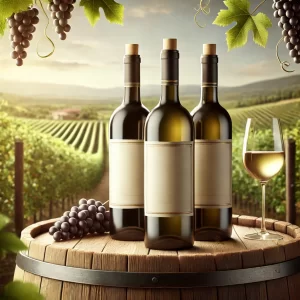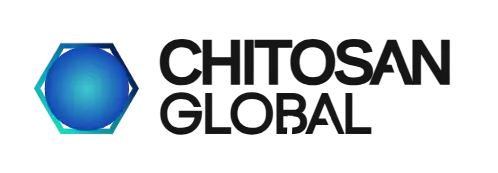Mushroom chitosan has been shown to have several benefits when used in winemaking. It can improve the clarity and stability of wine, as well as reduce the levels of unwanted compounds and off-flavors. Mushroom chitosan can also act as a natural preservative, which can extend the shelf life of wine and reduce the need for synthetic additives.

(1) Mushroom chitosan can remove undesirable compounds in wine
One of the main advantages of mushroom chitosan is its ability to bind with and remove undesirable compounds, such as proteins, tannins, and phenolics from wine.
This can help to reduce the risk of haze formation and improve the clarity and brightness of the wine. Moreover, mushroom chitosan can help to reduce the levels of sulfites, which are commonly used as preservatives in wine and can cause allergic reactions in some individuals.
(2) Mushroom chitosan can improve the stability of wine
Mushroom chitosan can also improve the stability of wine by reducing the risk of precipitation and sedimentation. This can help to prevent the loss of flavor and aroma compounds and ensure the quality of the wine over time. Moreover, mushroom chitosan can act as a natural antioxidant, which can help to protect against oxidative damage and maintain the freshness and flavor of the wine.
(3) Mushroom Chitosan can be used as a fining and stabilizing agent, eliminating Brettanomyces
It is used as a fining agent in the treatment of musts for flotation clarification to reduce cloudiness and the content of unstable colloids.
It is also used for stabilizing wines. This polymer helps eliminate undesirable micro-organisms such as Brettanomyces. 1

(4) Mushroom chitosan can promote sustainability & reduce environmental impact
Furthermore, the use of mushroom chitosan in winemaking promotes sustainability and reduces the environmental impact of wine production. Unlike animal-derived chitosan, which is obtained from crustacean shells and can contribute to waste and pollution, mushroom chitosan is derived from sustainable and renewable sources, such as fungi and plants.
Moreover, chitosan is biodegradable and does not accumulate in the environment, making it a safe and sustainable solution for winemaking.
The use of mushroom chitosan in wine applications has been extensively studied, and the results have shown its effectiveness and safety.
(5) Mushroom chitosan has no affect taste aroma or color of wine
Mushroom chitosan has been approved by regulatory agencies, such as the European Union and the United States Food and Drug Administration, as a safe and effective additive in winemaking. Moreover, mushroom chitosan has been shown to have no adverse effects on the sensory properties of wine, as it does not affect the taste, aroma, or color of the wine.

Mushroom chitosan is an effective and sustainable solution for wine applications. Its unique properties, such as detritus removal, stability enhancement, and natural preservation, make it an attractive alternative to animal-derived additives.
Moreover, the use of mushroom chitosan promotes sustainability and reduces the environmental impact of wine production. Therefore, it is expected that the use of mushroom chitosan will continue to grow in the wine industry as a safe and sustainable additive.
What is the dosage of chitosan in wine, beer and whiskey?
The dosage of chitosan used in clarification will vary by application.

In wine, chitosan is often used as a fining agent to clarify the wine by removing unwanted particles such as sediment and haze. The dosage of chitosan in wine can vary depending on the wine’s characteristics and the desired level of clarification. Typically, a dosage of 5 to 100 grams per hectoliter (100 liters) of wine is used, but it is important to follow the manufacturer’s instructions and to conduct trials before use to determine the optimal dosage.
In beverages such as juices, ciders and soft drinks, vegetal chitosan is often used as a stabilizer and thickener. The dosage of vegetal chitosan in these beverages can vary depending on the specific product and the desired texture and stability. In general, a dosage of 10 grams per hectoliter (100 liters) is used, but it is also important to follow the manufacturer’s instructions and to conduct trials before use to determine the optimal dosage.
In alcoholic drinks such as beer and spirits, chitosan can be used as a clarifying agent to remove unwanted particles and haze. The dosage of vegetal chitosan in these drinks can vary depending on the specific product and the desired level of clarification. Typically, a dosage of 10 to 100 grams per hectoliter of beer is used, but it is important to follow the manufacturer’s instructions and to conduct trials before use to determine the optimal dosage.

It’s important to note that the dosage of chitosan can vary depending on the specific product and the desired results, and it’s always recommended to consult the manufacturer’s instructions and conduct trials before use to determine the optimal dosage for your particular application.
More information about chitosan to control Brettanomyces Bruxellensis

(1) What is Brettanomyces Bruxellensis?
In the wine industry, B. bruxellensis is generally considered a spoilage yeast and it and other members of the genus are often referred to as Brettanomyces (“brett”). Its metabolic products can impart “sweaty saddle leather”, “barnyard”, “burnt plastic” or “band-aid” aromas to wine. Some winemakers in France, and occasionally elsewhere, consider it a desirable addition to wine. Some vintners consider brett to be responsible for 90% of the spoilage problems in premium red wines.
This undesirable yeast is able to develop during aging under difficult conditions. Development of this microorganism usually results in the production of off-flavors, such as ethylphenols and vinylphenols.
In fact, the sensory properties of these molecules (mousiness, animal, horsy, barnyard, smoky, spicy, burnt plastic, or medicinal) are often described as the Brett character.
It is also responsible for the production of other negative aromatic compounds such as isovaleric acid (known to be related to unpleasant cheesy aroma) and tetrahydropyridines, responsible for mousy taint.
Nowadays at an international scale, volumes concerned by this defect become significant, and Brettanomyces bruxellensis is considered as the major microbial cause for wine spoilage worldwide, causing significant economic losses.
Brettanomyces bruxellensis is well adapted to winemaking conditions since it is low pH and ethanol tolerant, facultatively anaerobic, and it can assimilate carbon sources alternative to hexoses.
Therefore, Brettanomyces bruxellensis and the consequences of its development in wines are a continuous threat for wine quality, and how to eliminate and control brettanomyces bruxellensis is one important key subject.
(2) Research about how chitosan controls Brettanomyces Bruxellensis
In the past years, from many operators in the wine industry, it was verified that chitosan of fungal origin was effective as a new tool to control Brettanomyces bruxellensis in the context of winemaking. 2
Chitosan is a linear polysaccharide composed of two repeating units [D-glucosamine units (GlcN) and N-acetyl-D-glucosamine (GLcNAc) units] randomly distributed along the polymer chain and linked by β(1-4)-bonds.
Recent studies have showed the impact of a fungal origin chitosan application on wines contaminated with Brettanomyces bruxellensis, leading to the elimination of Brettanomyces bruxellensis cells.
In these studies, the chitosan preparation was added, the wine racked off after 10 days and the efficiency of the treatment was evaluated in a short delay after the treatment.
This study focused on the evaluation of the impact of different addition protocols of an enological chitosan preparation on Brettanomyces bruxellensis population evolution and volatile phenols content along the aging, up to 9 months.

Meanwhile, recent other studies have showed the impact of chitosan application 9 on wines contaminated with Brettanomyces bruxellensis, leading to the elimination of Brettanomyces bruxellensis cells, even at high levels of populations up to 10 5 -10 6CFU/mL.
Due to the necessity to control wine microbiological stability during the period of aging in barrels, our research focuses on the application of an enological chitosan preparation in order to prevent wine from Brettanomyces bruxellensis contamination along the aging period at both experimental winery- and winery-scale.
Moreover, since previous studies have reported that the management of an efficient malolactic fermentation (MLF) can help to preserve the quality of wine by hampering the development of Brettanomyces yeast, the application of chitosan treatments in this work has been carried out both on wines that underwent rapid MLF (by yeast-bacteria co-inoculation) and on wines that underwent slow MLF (carried out by spontaneous microflora).

The results confirm the interest of fungal origin chitosan as a preventive tool to control Brettanomyces bruxellensis in the context of wine aging Brettanomyces bruxellensis and the consequences of its development in wines are a continuous threat for wine quality.
Discussion of chitosan in wine applications
Chitosan is a biopolymer derived from chitin, a natural polymer found in mushrooms and shellfish. Mycelium chitosan, on the other hand, is a type of chitosan produced from fungal mycelium or other plant sources: both mushrooms and aspergillus niger.
In wine applications, chitosan can be used as a fining agent. Fining agents are substances that are added to wine to remove unwanted impurities, such as sediment, haze, or off-flavors, and improve the clarity and stability of the wine.

The benefits of using musroom chitosan as a fining agent in wine include:
- 1. Removal of impurities: Mushroom chitosan can elimination of Brettanomyces bruxellensis cells and remove suspended particles, including yeast cells, bacteria, and tannins, that can cause haze or sediment in the wine.
- 2. Clarification: By removing these impurities, mushroom chitosan can clarify the wine, improving its appearance.
- 3. Stabilization: Mushroom chitosan can help stabilize the wine by binding with and removing compounds that can cause wine spoilage, such as sulfur dioxide, metals, and oxidized phenols.
- 4. Reduced allergenicity: Unlike animal-based chitosan, mushroom chitosan is free from allergens and can be used by vegetarians and people with shellfish allergies.
To conclude, mushroom chitosan can be an effective and sustainable alternative to animal-based fining agents in the wine industry.
References:
- Chitosan and its applications in Oenology – https://oeno-one.eu/article/view/7262
- Evaluating the impact of a fungal-origin chitosan preparation on Brettanomyces bruxellensis in the context of wine aging – https://www.researchgate.net/publication/270890454_Evaluating_the_impact_of_a_fungal-origin_chitosan_preparation_on_Brettanomyces_bruxellensis_in_the_context_of_wine_aging
Book a Free Consultation
If you don’t know what type of chitosan is best for your situation, Book an appointment. we will offer you an initial 30-minute consultation and product quotation at no charge.
